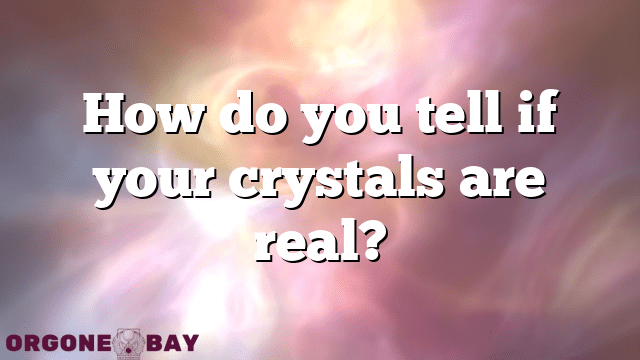Crystal Myths Controversies & Misconceptions
How do you tell if your crystals are real?
Crystals are not just a stunning decor item, but also a powerful tool for emotional, physical, and spiritual healing. But what if you’re unsure if your crystals are real or fake? Here are some telltale signs of a genuine crystal:
• Cool and smooth to touch: Natural crystals feel cool and smooth to the touch, and they have a certain weight to them. Unlike plastic, glass, or other synthetic materials, genuine crystals don’t warm up quickly or feel lightweight.
• No Scratches or Imperfections: Real crystals don’t have scratches or chips that can be seen with the naked eye. Synthetic crystals may have bubbles or other markings, and heat-treated crystals can have a cloudy or uneven appearance.
• Weight: Genuine crystals are generally heavier than fake crystals of the same size.
While it’s great to have natural crystals for their energy and healing power, synthetic and heat-treated crystals still have their benefits. They can be a cost-efficient way to add crystals to your collection and are still an excellent option for healing, meditation, or manifesting. It’s all about your intentions and connection to the crystals, not just their authenticity. Remember to cleanse and charge your crystals regularly, regardless of their origin.
Table Of Contents
- 1 Physical Characteristics of Natural Crystals
- 2 Tactile Sensations: Assessing Texture and Temperature
- 3 Imperfections and Inclusions: Identifying Authenticity
- 4 Weight: A Key Indicator of Genuine Crystals
- 5 Synthetic Crystals: Understanding the Differences
- 6 Heat-Treated Crystals: Their Properties and Importance
- 7 Authenticity vs. Efficacy: Why Both Matter in Crystal Healing
- 8 Tips for Identifying Real Crystals and Avoiding Fakes
Physical Characteristics of Natural Crystals
Natural crystals are formed over millions of years through geological processes and can be found in rocks, caves, and mines. These crystals are unique in their physical characteristics, making them easily distinguishable from synthetic or fake crystals. Natural crystals have a geometric structure, have a distinct color and transparency, and often have inclusions or imperfections that show they were formed organically.
Tactile Sensations: Assessing Texture and Temperature
One of the most reliable ways to determine if a crystal is real is through touch. Natural crystals feel cool and smooth to the touch, whereas synthetic or fake crystals may have a plastic or glass-like texture. A natural crystal will usually be cool to the touch because it retains the temperature of the space it was formed in. It’s essential to note that a crystal’s temperature may vary depending on the area it comes from. Some crystals may feel warmer than others, making the expertise of a crystal expert necessary.
Imperfections and Inclusions: Identifying Authenticity
Just as people have unique characteristics, natural crystals often have inclusions or imperfections that make them one of a kind. When examining a crystal, look for small air bubbles, lines, or color variations that can signify authenticity. Fake crystals are typically smooth and flawless, lacking any unique features found in natural crystals.
Weight: A Key Indicator of Genuine Crystals
Another way to determine a crystal’s authenticity is through weight. Natural crystals are generally heavier than synthetic or fake crystals. The difference in weight is due to the density of the minerals and elements that make up natural crystals, which can range from quartz to amethyst. However, this method may be subjective since there is a range, so accurate knowledge of each type of crystal is necessary.
Synthetic Crystals: Understanding the Differences
Synthetic crystals are produced artificially by replicating the geological process that occurs in nature. The process involves melting minerals, forming a crystal using a seed crystal, and slowly cooling it over time. Synthetic crystals are usually less expensive than natural crystals and can be produced in any size or shape, making them a suitable replacement for natural crystals when needed. They can also have unique features that are not present in natural crystals.
Heat-Treated Crystals: Their Properties and Importance
Heat-treated crystals are created by heating natural crystals in a process that changes their color or transparency. For example, amethyst can be heated to create citrine, which is a yellowish-brown color. Heat-treated crystals may lack the unique features seen in natural crystals, but they can still have similar healing properties. They are used primarily for decorative or ornamental purposes, though they can still be used for meditation or manifesting.
Authenticity vs. Efficacy: Why Both Matter in Crystal Healing
While natural crystals are highly prized for their unique features and authenticity, synthetic and heat-treated crystals can still be effective in healing, meditation, or manifesting. However, the efficacy of a crystal is highly dependent on its origin and authenticity. It’s essential to ensure that the crystal you use genuinely resonates with your energy to enhance your spiritual practice.
Tips for Identifying Real Crystals and Avoiding Fakes
– Research the type of crystal you are interested in buying and understand its physical characteristics.
– Buy from a reputable dealer who specializes in natural crystals.
– Look for inclusions or imperfections that show a crystal’s organic formation.
– Check the weight of the crystal to determine its authenticity.
– Use touch to feel the temperature and texture of the crystal.
– Avoid crystals that are too cheap or have an unnatural appearance.
– Trust your intuition and inner knowing when selecting a crystal.
In conclusion, natural crystals have unique characteristics that make them highly valued for their authenticity and efficacy. Synthetic and heat-treated crystals can still be used for spiritual practice, but understanding the differences between natural and fake crystals is crucial. Follow the tips outlined above to ensure that your crystals are authentic and resonate with your energy.

